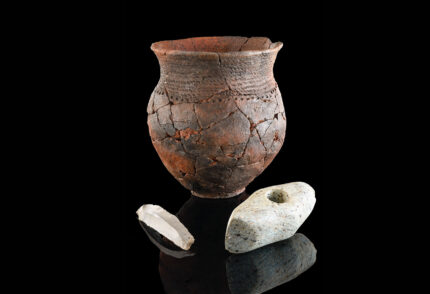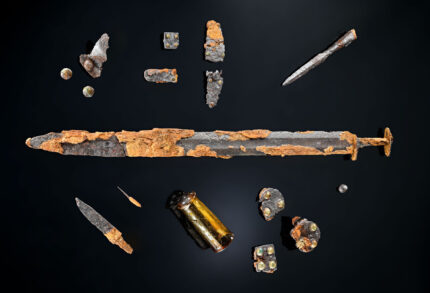Rare graves from the Neolithic and early medieval Migration Period have been discovered in Tuttlingen, in southwestern Germany near the Danube Sinkhole. A preventative archaeology excavation at the site of a planned rainwater retention basin unearthed a Stone Age grave of the Corded Ware culture containing grave goods including a characteristic pot of the type that gave the culture its name, and dozens of Migration Period (ca. 375-568 A.D. ) graves containing weapons and jewelry.
Only one Neolithic grave has been found so far — Corded Ware culture graves are rare in southwestern Germany — but archaeologists did discover the remains of a prehistoric settlement. The grave contained a corded ware beaker, decorated at the neck by winding a rope around it when the clay was still wet to create a dimpled effect. It also contained a stone axe with a neat hole in the middle where the handle was once mounted and a flint blade. The Corded Ware grave dates to the 3rd millennium B.C.
The Migration Period cemetery is large with about 140 burials, and many of them are richly furnished. This was a period of mass movement of people throughout Europe in the wake of the collapse of Roman power. They usually travelled in tribes of about 10,000-20,000 lead by a warlord until they found a place they wanted to settle. The cemetery dates to the later Migration Period.
“Most burials contain grave goods such as weapons, e.g. swords, lances, shields, and jewelry such as glass beads, earrings, belts or belt pendants,” said Dr. Andreas Haasis-Berner, responsible area officer at LAD, today (August 18, 2022) presenting the current results in Gutmadingen together with the excavation company and the city. Bone combs or a drinking glass are special features. Based on these grave goods, the burial ground can be dated to the 6th century.


One might wonder about the ‘Tulingi’ people, who with some of the ‘Boii’, had joined the ‘Helvetians’ on their very own migration into “Gallia Transalpina”, all beaten by Julius Caesar in the ‘Battle of Bibracte’ (cf. Bk. 1 in his ‘Description’):
Apparently, the ‘Tulingi’ lived north of the Helvetians and east of the Rhine. “He [i.e. Caesar] ordered the Helvetii, the Tulingi, and the Latobrigi, to return to their territories from which they had come” (1.28). … “In the camp of the Helvetii, lists were found, drawn up in Greek characters, and were brought to Caesar […] Of all which items the total was: Of the Helvetii 263000, of the Tulingi 36000, of..” (1.29).
West of Lake Constance, there are a couple of notable hills and hillforts, e.g. the “Castellum Tuil”, today known as the “Howentwiel”, already inhabited in the Stone Age. Also, “Tuttlingen” with its Honberg may be related.
Of course, the sword from 500 years later may be Alemannic.